Rashtrakuta rulers contribute
Origin of Rashtrakuta rulers – The word Rashtrakuta means – the officer with the authority of a regional entity called Rashtra. 7th and 8th century the land grants of Rashtrakutas have been payed for, that they should not disturb the peace of the given area. The Rashtrakutas were originally from Latralur in Maharashtra, modern Latur. He was of Kannad origin and Kannand was his mother tongue.
Rulers of Rashtrakuta dynasty –
Dantidurga(दांतिदुर्ग) –
Dantidurga started his life as a feudatory of the Chalukyas. He laid the foundation of a long-term kingdom. We learn about Dantidurga’s conquests from two sources – first, the Samagad Patra and second, the Dashavatar cave inscription of Ellora. The conquest of Dantidurga was intended to be east and west, and he did not want to leave Karnataka, the Chalukyan stronghold. He attacked Malwa, which at that time was under the Gurjar Pratiharas, and captured it. In celebration of his victory over Malwa, he performed the Hiranyagardhan festival in Ujjain. After a few days he went to Mahakoshal or Chhattisgarh region of Madhya Pradesh. He then attacked his lord Chalukya king Kirtivarman-II and declared himself the lord of the entire south. But after this victory, he did not live long.
Krishna-I (कृष्ण-I) –
Dantidurga had no children. He was followed by his uncle Krishna-I on the throne. After consolidating its position in Maharashtra and Karnataka, Krishna-I moved south. He invaded Gangavadi (modern-day Mysore), which he returned at that time by allowing the Ganga king Sripurush to rule as his subordinate. In the past, Krishna-I was confronted by the Chalukyas of Vengi. He sent Raj Kumar Govind to Vengi, where the ruler Vijayaditya-I surrendered without any struggle. Krishna was also a great producer, with a great winner. He built a magnificent huge single stone cut stone temple at Ellora, Which is now known as Kailash.
Govind-II(गोविंद-II) –
After Krishna-I, his eldest son Govind-II ascended the throne. In fact, he left the entire administration to his younger brother Dhruv. Dhruv was ambitious, he himself took over the throne.
Dhruv (ध्रुव) –
Soon after coming to the throne, Dhrav started punishing the kings who supported his brother. After that Dhruva made a bold attempt to control the politics of North India, Which no South Indian power could do after the Satavahanas. At that time there was a struggle between Vatsaraja Pratihara and Pal ruler Dharampal of Bengal for the superiority in North India.
When Vatsaraja was at war with Dharmapala in Doab, Dhruv crossed the Narmada and captured Malwa without facing much resistance. After that he marched towards Kannauj and defeated Vatsaraja so badly, that he had to take refuge in desert of Rajasthan. Proceeding north, Dhruv passed Dharmapala in the Ganges-Yamuna Doab region. The royal city did not go towards Kannauj and returned with a large store of Dhruv loot.
He had four sons – Karak, Stambh, Govind and Indra. Karak has died before his father. Of the remaining three sons, the king chose the most qualified Govind as his successor and made him crown prince.
Govind III ( गोविंद-III ) –
Although Govind came to post with Shante, he soon had to face opposition from his elder brother Stambh, the one who abdicated the throne’s claim was made king. After defeating the stambh and consolidating his position in the south, Govind also turned his attention to the political situation in North India. Govind turned to North India and defeated Nagabhatta-II. Nagabhatta fled to Rajputana leaving Doab at the mercy of the invaders. The puppet rulers of Kannauj, Chakrayudha and Dharmapala surrendered unconditionally. Apart from the powerful Gurjar Pratihara and Pala kings, other kings of North India were also defeated by Govind-III.
Amoghavarsh-I (अमोघवर्ष-I) –
Govind-III was followed by his son Sarva, popularly known as Amoghavarsha. He did not get peace during his long reign of 64 years. He had to face many rebellions of his feudatories during his reign and fight with his powerful neighbors. His father’s prodigies were lacking in the early years. Malwa and Gangawadi were taken away from his kingdom.
Instead of war, he was more interested in peace, religion and literature. In the first half of his life, he turned to Jainism and Jinsen, the author of Adipuran, was his chief teacher. Amoghavarsh himself was a writer and gave great encouragement to litterateurs. He himself was the author of Kaviraj Marg, the first book on poetry in Kannada language. He built the city of Manyakhet and also built a magnificent palace there. He was succeeded by his son Krishna-II.
Krishna III
He was neither a good ruler, nor a skilled army chief. His only achievement was the end of the Gujarat branch. He was able to fight only against Bhoj-I and his war with Vengi and Cholas proved disastrous. Like his father Amoghavarsha, Krishna was also a Jain.
Indra III( इंद्र-III )
Krishna-II was followed by his grandson Indra III. Raising the pride of his great ancestors, Indra waged war with the Gurjar Pratihara king Mahipal. He captured Kannauj. Creating problems for the rulers of Vengi, he made his representative sit on the throne there.
Amoghavarsh-II (अमोघवर्ष-II)
Indra-II was followed by his son Amoghavarsha II, but died within a year of his arrival on the throne and was replaced by his younger brother Govind.
Govind – IV (गोविंद – IV )
Govind was a cruel ruler against whom there was widespread discontent. One of his chiefs gave extensive support in ending the rule of Govind IV and the power was transferred to Amoghavarsha III.
Amoghavarsh-III (अमोघवर्ष-III)
He was more interested in religion than in administration. The task of governance was in the hands of Crown Prince Krishna-III.
Krishna-III( कृष्ण-III )
After coming to the throne, Krishna spent a few years improving the administration. Krishna made a sudden attack on the Chola kingdom and captured Kanchi and Tanjore. It took a few years for the Cholas to overcome it and in 949 BC the decisive battle of Takkolam was fought in North Arcot. Moving towards the south, Krishna also defeated the rulers of Kerala and Pandya and for some time he had authority over Rameshwaram. Constructed many temples in the state won by him, among which Krishnaveshwara and Gandamatandya temples of Rameshwaram are famous. During his long reign, Krishna-III had full authority over Tondaimandalam, which included Arcot, Chingleput and Vellore districts.
Like most of his ancestors, Krishna III took interest in the case of Vengi, but the Rashtrakuta rule did not last long in Vengi. In the last days of his rule, Krishna attacked Harsha Siak, the Paramar ruler of Malwa and took over Ujjain.
The decline of Rashtrakuta rule started from the time of Krishna. He was unaware of those feudal activities of the state, Which originated from giving Taradavi in the middle of the state as a jagir, And thereby threatened the stability of the state. Within a few years of Krishna’s death Telap became so powerful that he overthrew the Rashtrakutas and established the Western Chalukya dynasty of Kalyani.
Khotiga (खोट्टिगा )
After Krishna III his brother came to Khotiga. During his reign, the Rashtrakuta kingdom suffered a severe setback, destroying its reputation. Parmar had not forgotten his defeat at the hands of King Siak Krishna III and was looking for revenge. Siak invaded the Rashtrakuta capital Malkhed and Khotiga could not live longer with this insult. Then came his nephew Karak-II.
Karak-II(करक-II)
By the time Karak came to the throne, the reputation of the state had been severely damaged. The situation became worse due to the misrule of the new king. Samantas naturally began to challenge the central power and one of them took away the kingdom of the south from Karak within 18 months of coming to the throne. He was Tel-II (Telap) of the Chalukya dynasty.
Reference : https://www.indiaolddays.com



